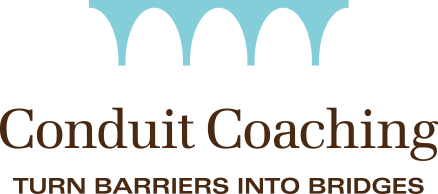It’s been a busy and fun fall over here at Conduit Coaching.
I’ve had the privilege of leading the Academy for Compassionate Leadership, supporting organizations to lead from their strengths, facilitating scenario-based workshops to expand leaders’ capacity, and piloting SCORE (a program that strengthens cultures of respect and engagement).
All this activity has highlighted three eternal truths.
 Eternal Truth #1: Leaders get a ton of value from hitting the pause button (aka reflecting), a key component of every Conduit Coaching program.
Eternal Truth #1: Leaders get a ton of value from hitting the pause button (aka reflecting), a key component of every Conduit Coaching program.
Eternal Truth #2: Folks super-appreciate the opportunity to practice reflecting together.
Eternal Truth #3: People think “this is great” and wonder “why didn’t we do it before?”
My answer to that last question?
For high-achieving go-getters (i.e. you), sitting still to THINK is, well, not so comfortable, maybe weird even. Hmmm.
So, as with most unpalatable but good-for-us things, we decide we don’t have time for it. (After all, it can take up to 10 minutes. O brother.)
Is it really worth it?
So why bother investing a few minutes on your own, or a few hours with your colleagues, to get past the discomfort? Is there real power in the pause?
Don’t take it from me. Here’s what three recent workshop participants said:
1. You learn about yourself and your colleagues — namely that you each bring special and unique combinations of traits, and can lean on one another when you need a different perspective.
All true. All relevant.
Increased self-awareness boosts emotional intelligence and leadership effectiveness
while strengths-aware teams improve significantly in key performance measures
like turnover, employee engagement, safety and profit.
 2. I loved hearing from others, especially those I don’t typically interact with. I remembered I’m not alone and realized how alike we all are in our fears and beliefs about ourselves. And that as leaders, we all go through similar experiences and challenges.
2. I loved hearing from others, especially those I don’t typically interact with. I remembered I’m not alone and realized how alike we all are in our fears and beliefs about ourselves. And that as leaders, we all go through similar experiences and challenges.
Yup. It can feel lonely at the top.
Meanwhile, connection inspires collaboration and creativity, improves communication,
and deepens a sense sense of belonging, vital for personal health.
3. We talked about significant leadership topics we usually never get around to, like what’s important to us individually and as an organization.
It’s Stephen Covey’s prioritizing not-urgent-but-important tasks advice, in action. Reflecting on past experiences and learnings helps us apply insight going forward.
Otherwise? Groundhog Day, here we come. Oy.
Practice the Strategic Pause.
You’re convinced? Excellent. Let’s do it.
Stop and Ask
 Move through Julie Winkle Giulioni’s Reflexive to Reflective leadership continuum. Step out of fix-it mode, get curious and listen.
Move through Julie Winkle Giulioni’s Reflexive to Reflective leadership continuum. Step out of fix-it mode, get curious and listen.
When you’re modeling the strategic pause you help others reflect too, making thoughtful, well-reasoned decisions more likely.
Stop and Share
Channel leadership guru Patrick Lencioni: Use the same discipline muscle that helps you get stuff done to stop, at least once each day, and sit in (possibly) uncomfortable silence to think. Five, maybe 10, minutes. That’s it.
And . . . You may be shocked to discover the world won’t stop if you do. (What?!)
You’ll start learning more, being more productive, and probably even feel happier.
Another happy surprise? As your pausing muscle strengthens, reflecting becomes easier, intuitive even.
Stop and Think
And. The really big gains come when you make reflecting a team sport.
That’s why . . .
 Retrospectives are an essential element in Agile software development because they reinforce the importance of continuous improvement.
Retrospectives are an essential element in Agile software development because they reinforce the importance of continuous improvement.- Hospitals often conduct Schwartz Rounds, group reflective practice forums that give staff an opportunity to reflect on the emotional and social aspects of their work.
Results? Increased confidence in dealing with sensitive patient-related issues, improved teamwork and interdisciplinary communication, and positive organization-wide practice changes.
How to get the most value from the conversation? Step back and let someone else facilitate the conversations, perhaps a colleague from another team or an external person like that special someone. It makes it easier for everyone to participate in the conversation and reap the benefits.
Because yes, participants tell us programs like the Leadership Academy or Strengths Spotlight are pretty great venues for leaders through-out their organization to
be together, grow and reflect together, learn together.
Stop to Win.
 Even the super heroes among us need the occasional nap to maintain performance.
Even the super heroes among us need the occasional nap to maintain performance.
Using your leadership position to help team members develop the habit of reflection builds trust, and makes them happier and more productive individually and collectively, with cascading benefits for the entire organization.
Sounds like a win for the people you lead, win for you, win for the organization . . . don’t you think?
Me too.
Especially for Leaders & Teams in Seniors Care.
You’re in your job for a reason. You’re really good at what you do and you get a lot done, which is pretty important since, well, there’s a ton of change and a lot to do.
So pausing, taking a beat before responding, may feel. . . odd. Unnatural. A waste of time.
Ok. And. If you asked any of your residents if taking a moment to be with those around you, listen to what they have to say, and reflect on what’s been happening is something they wish they’d done more of. . . it’s pretty likely they’d say yes.
Leadership means being a resource and coach, and also encouraging employees to have a voice. Moments of reflection with your team make it easier for that to happen. It can shift the direction of things and of people, leading to new possibilities.
It’s not about umpteen hours staring at your navels.
A few well-chosen moments really can make a difference.






